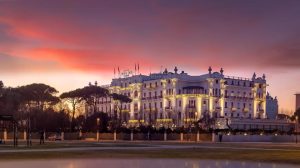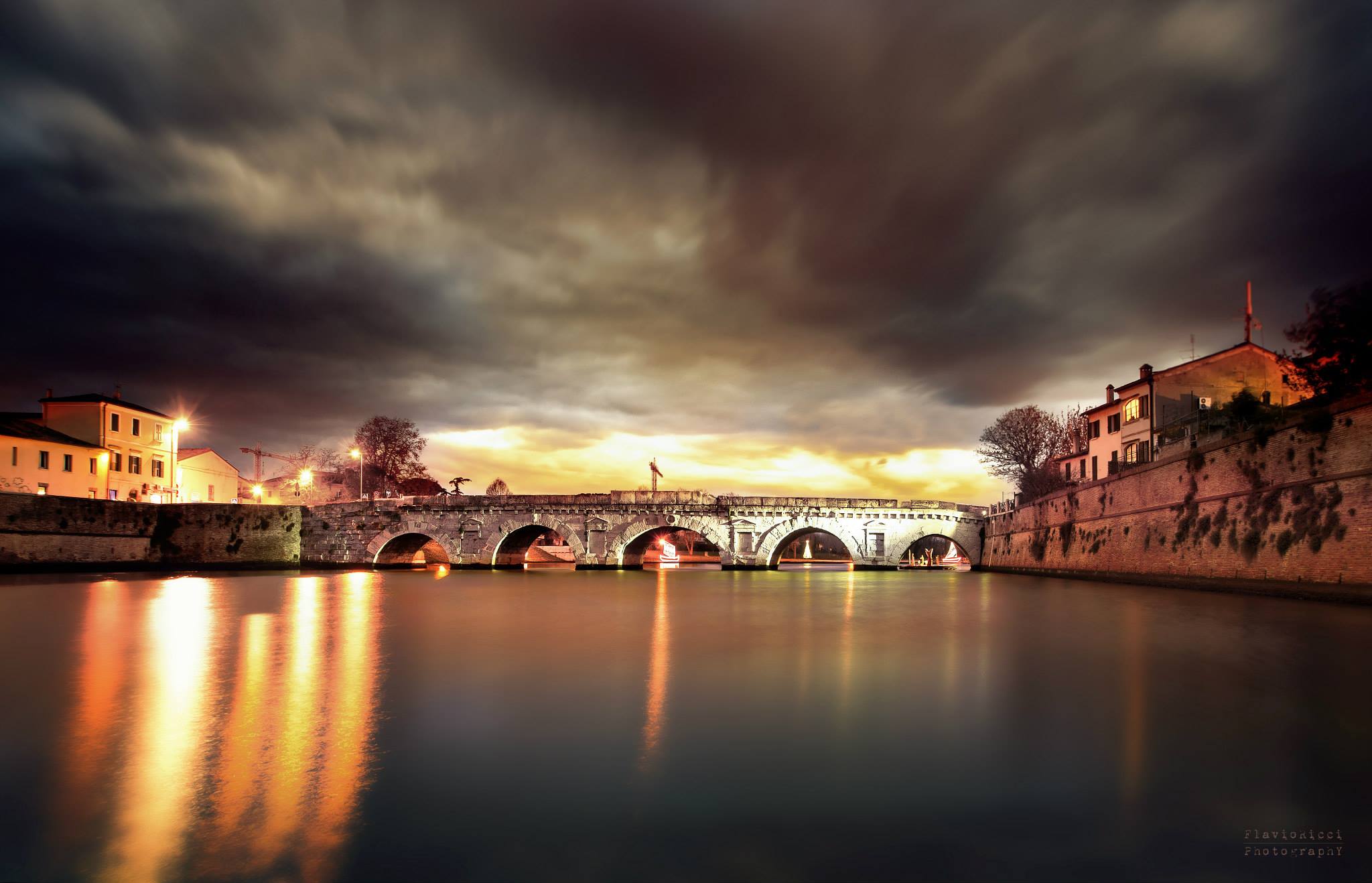
There are places that need no explanation. You simply step inside, and something shifts within you. The Grand Hotel in Rimini is one of those places.
It has officially been a National Monument since 1994, but in truth, it always was — long before the official title, long before history stepped in to honor it with capital letters. Because this is not just a hotel. It’s a vision.
It all began in 1906, when Swiss architect Paolito Somazzi was commissioned by SMARA – Società Milanese Alberghi Ristorazione ed Affini. This company had acquired management of Rimini’s seaside facilities, which at the time included a pier and the Kursaal but lacked one crucial element: a hotel grand enough to match the dreams that were about to arrive.
Italy was discovering seaside tourism. And even then, Rimini knew that sand and salt wouldn’t be enough. It needed something spectacular. A palace of dreams, a temple of hospitality that could rival the hotels of the French Riviera and the North Sea.
And so the Grand Hotel was born. Its horseshoe shape — a stone embrace of elegance and ambition — took form with a clear goal: not just to accommodate, but to captivate.
With around 250 rooms outfitted with the highest level of comfort for the time, it was immediately clear: this wasn’t just a hotel. It was a promise — the promise of experiencing Rimini with the eyes of an aristocrat and the heart of a dreamer.
But it’s the architectural style that makes the Grand Hotel truly unique. A blend of historicist grandeur — with classical and Renaissance-inspired elements like mascarons, garlands, and monumental details — and the graceful lines of Art Nouveau. Wrought iron balconies, stylized female figures, flowing lines that ripple like waves — it all speaks of a beauty that asks for no permission.
On July 1st, 1908, the doors opened — and with them, a new era. Rimini introduced itself to the world with a slogan that may sound quaint now but was boldly visionary then: “Rimini, the Ostend of Italy.” It was no small comparison: Ostend, the Belgian pearl, was queen of aristocratic European tourism. Yet, within just a few years, Rimini no longer needed to resemble anyone.
It proved that with Marcello Dudovich’s 1922 poster, featuring the red dolphin that still leaps in our collective memory.
Curiously, the Grand Hotel’s façade doesn’t face the sea — it looks inland, toward the heart of Rimini: Piazzale Fellini, once Piazzale Risorgimento, home of the legendary Kursaal.
It was here, on this open-air stage, that the summer of Rimini came to life for decades: the Corso dei Fiori, equestrian shows, and major beach events. It was a grand outdoor parlor, a place where elegance was on display, and time seemed to stand still.
Today, you might walk across that square without giving it much thought. Maybe you’re just looking for an ice cream, a sunset, a photo for your feed. But if you stop for a moment and truly look at the Grand Hotel, you realize — it’s not just a building. It’s a piece of the city’s soul. A memory made of marble and dreams.
The Soul’s Refuge: Federico Fellini, Rimini, and Suite 315
There’s a Rimini that Fellini portrayed in his films. But there’s another Rimini he carried in his heart — and it welcomed him, silently, every time he needed to come home.
That Rimini had a specific address. A number. A key. Suite 315 of the Grand Hotel.
It may sound incredible, but Amarcord wasn’t filmed in Rimini. It was entirely shot in Studio 5 at Cinecittà, which now bears his name.
And yet, the truest Rimini, the most intimate one — the one that needs no sets — was all there, in room 315 of the Grand Hotel.
Because this wasn’t just a hotel room. It was his personal refuge. A place where he could shed the role of director and simply be a son, a friend, a man.
When he returned to Rimini — to visit his mother, to reconnect with old friends, to embrace his lifelong companion and alter ego, lawyer Titta Benzi — Fellini never booked in advance. He simply went straight to his suite.
It was Pietro Arpesella, a key figure in Rimini’s hotel industry and then-owner of the Grand Hotel, who reserved it permanently for him. The most beautiful room. The most theatrical. The one with the best sea view.
Picture this:
A quiet autumn morning. The Grand Hotel enveloped in elegant silence. At the window of Suite 315, Fellini gazes at the sea. The waves, the fog, the boats on the horizon. Maybe there’s a notebook on the table. Maybe just his thoughts.
That sea raised him. It made him a visionary. That hotel inspired him — becoming a pillar of his life and cinema.
When Fellini returned to Rimini, he was no longer the boy from the backstreets or the novice journalist.
He was a man who had invented a cinematic language. An artist in search of a place that could contain memory without overwhelming it.
That place was a suite. Suite 315. Not just a hotel room. A time capsule. A refuge where he could reconnect with his childhood — No special effects. No sets.
Just the muffled silence of the corridor, The scents of Romagna, The familiar gestures of the waiters, The voices echoing through the rooms.
There, just steps from the lobby yet a world away, Fellini could observe. Remember. And maybe even write.
There’s no need to describe the furnishings. True luxury speaks softly.
But one thing is worth saying:
The view from 315 — that sea view — never fades. Not even on grey days. Not even when the waves blend into the sky.
Because from that window, Fellini never stopped seeing Rimini through the eyes of a dream.
To tell the story of that room is to step quietly into collective memory. It’s to recognize that a hotel room can hold more than just a stay. It can hold a piece of Italian cinema. A fragment of a city’s soul.
Room 315 is not open to the public. It’s not a museum. But it’s there.
And it remains, at the heart of Rimini, both a real and symbolic place. A point of return. A beginning and an end.
That’s why, when I say that Rimini is not just about beaches and aperitifs, but also about memory, art, and roots, I invite you to look up. Yes, right there — Where one day, from the window of Suite 315, a man in a dark jacket stared out at the Adriatic. And he was remembering. Or maybe he was writing. Or maybe… just maybe… He was becoming a child again.
Beyond the Film: Amarcord, Memory, and Rimini’s Influence on Fellini

Federico Fellini, born in Rimini, maintained an unbreakable bond with his hometown. Though it changed with time, it was never severed.
And even if Amarcord — his most autobiographical film — was shot entirely in Cinecittà’s Studio 5, you can’t grasp its essence without returning to its roots: The alleyways, the characters, the atmosphere of the old Rimini.
In this journey of memory and inspiration, the Grand Hotel plays a central role.
Declared a National Monument in 1994, designed in 1906 by Swiss architect Paolito Somazzi, it remains a historic and architectural icon of the city.
It wasn’t just where Fellini stayed. It was the starting point for his returns — to see his family and lifelong friends, like lawyer Titta Benzi, real-life inspiration for one of the most iconic characters in his films.
There, on the third floor, Suite 315 awaited him — Considered the most beautiful room in the hotel, with a breathtaking view of the sea.
It was Pietro Arpesella, the visionary entrepreneur who managed the hotel in the ’70s and ’80s, who made sure it was always available for him.
That room, with its windows overlooking the Adriatic, became the refuge of a man who had brought dreams to global cinema, yet continued searching for the echoes of his childhood.
We don’t know exactly what Fellini found in that room. But we know he returned often. And he always chose that room.
Maybe that’s all you need to know — His loyalty to that place, and that view — to understand how Rimini lived on in his imagination.
Even the hotel’s architecture — its neo-Renaissance festoons and mascarons, wrought iron balconies, Liberty-style decorations, and horseshoe-shaped structure — tells a story of splendor and vision.
An era that Fellini knew how to transform on film, blending memory and fantasy.
And then there’s Rimini itself. A city that, like him, never stayed the same.
From 19th-century therapeutic bathing — regulated by the 1873 “Hygienic Code for Sea Baths” — to the glamorous 20th-century seaside retreat, Rimini evolved, transforming even its Liberty villas into boutique hotels.
A quiet metamorphosis, like its streets in late summer. A city that still whispers — and still inspires.
Fellini kept returning. Not out of empty nostalgia, but to rebuild the thread of an identity no red carpet could erase.
So yes, Amarcord wasn’t filmed here. But it could never have been born anywhere else.
The Suite, the City, and the Invitation
In the next chapter, I’ll take you inside the room where all of this condensed into a window, a light, a silent presence: Suite 315.
Because Rimini is not just sea and nightclubs. It’s art, memory, and form. And now, more than ever, it deserves to be rediscovered.
Not just beach umbrellas and cocktails. But a city of memories, visions, and artists. The Rimini that nurtured Fellini. And that — if you know how to look — still nurtures you today.
That’s why I chose to tell this story. That’s why ScopriRimini.it was born.
Because when you come to this city, I want to offer you more than just a tidy room or a great breakfast.
I want to give you a key. A key to authentic access — the kind only someone who has lived here for over 30 years can give you.
A key to the places of memory hidden between the lines of guidebooks, but still ready to speak — if you know how to listen.
Suite 315 is a symbol. But it’s not the only one.
So are the 19th-century villas turned boutique hotels. The alleyways of Santarcangelo. The benches by Rimini’s port. Even Dudovich’s red dolphin, from a poster that made generations dream.
They are all signs. Clues. Traces of a deeper identity.
So, if you’ve read this far… It means you’re not satisfied with the surface. You want to go deeper.
And if you’d like, I’m ready to guide you.
From where? From the Aqua Hotel. That’s where I work.
It’s where I meet people every day — people who arrive to disconnect…
and leave with a new Rimini in their eyes.
A Rimini that reveals itself. That surprises. That stays with you.
👉 Come to Rimini. Discover the Aqua Hotel and our current offers.
It’s the perfect place to begin seeing this city…
with new eyes.
With true eyes.





